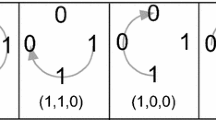Abstract
Communication or influence networks are probably the most controllable of all factors that are known to impact on the problem-solving capability of task-forces. In the case connections are costly, it is necessary to implement a policy to allocate them to the individuals. Here we use an agent-based model to study how distinct allocation policies affect the performance of a group of agents whose task is to find the global maxima of NK fitness landscapes. Agents cooperate by broadcasting messages informing on their fitness and use this information to imitate the fittest agent in their influence neighborhoods. The larger the influence neighborhood of an agent, the more links, and hence information, the agent receives. We find that the elitist policy in which agents with above-average fitness have their influence neighborhoods amplified, whereas agents with below-average fitness have theirs deflated, is optimal for smooth landscapes, provided the group size is not too small. For rugged landscapes, however, the elitist policy can perform very poorly for certain group sizes. In addition, we find that the egalitarian policy, in which the size of the influence neighborhood is the same for all agents, is optimal for both smooth and rugged landscapes in the case of small groups. The welfarist policy, in which the actions of the elitist policy are reversed, is always suboptimal, i.e., depending on the group size it is outperformed by either the elitist or the egalitarian policies.
Graphical abstract

Similar content being viewed by others
References
S. Reijula, J. Kuorikoski, Modeling epistemic communities, inThe Routledge Handbook of Social Epistemology, edited by M. Fricker, P.J. Graham, D. Henderson, N.J.L.L. Pedersen (Routledge, Abingdon, UK, 2019)
P. Kitcher,The Advancement of Science: Science Without Legend, Objectivity Without Illusions (Oxford University Press, New York, 1993)
H. Bloom,Global Brain: The Evolution of Mass Mind from the Big Bang to the 21st Century (Wiley, New York, 2001)
D. Lazer, A. Friedman, Admin. Sci. Quart. 52, 667 (2007)
R.L. Goldstone, M.E. Roberts, W. Mason, T. Gureckis, Collective search in concrete and abstract spaces, inDecision Modeling and Behavior in Complex and Uncertain Environments, edited by T. Kugler, J.C. Smith, T. Connolly, Y.-J. Son (Springer, New York, 2008), pp. 277–308
J.F. Fontanari, PLoS ONE 9, e110517 (2014)
J.F. Fontanari, Eur. Phys. J. B 88, 251 (2015)
S.M. Reia, A.C. Amado, J.F. Fontanari, Phys. Life Rev., https://doi.org/10.1016/j.plrev.2018.10.004 (2019)
E. Gilbert, SIAM J. Appl. Math. 9, 533 (1961)
S.A. Kauffman, S. Levin, J. Theor. Biol. 128, 11 (1987)
R.K. Merton,The Sociology of Science: Theoretical and Empirical Investigations (University of Chicago Press, Chicago, 1973)
M. Strevens, J. Philos. 100, 55 (2003)
M. Perc, J.J. Jordan, D.G. Rand, Z. Wang, S. Boccaletti, S. Attila, Phys. Rep. 687, 1 (2017)
S.A. Kauffman,At Home in the Universe: The Search for Laws of Self-Organization and Complexity (Oxford University Press, New York, 1995)
H. Kaul, S.H. Jacobson, Math. Program. 108, 475 (2006)
D. Solow, A. Burnetas, M. Tsai, N.S. Greenspan, Complex Syst. 12, 423 (2000)
W. Hordijk, S.A. Kauffman, P.F. Stadler, Theory Biosci., https://doi.org/10.1007/s12064-019-00296-0 (2019)
M. Starnini, A. Baronchelli, R. Pastor-Satorras, Phys. Rev. Lett. 110, 168701 (2013)
P.F Gomes, S.M. Reia, F.A. Rodrigues, J.F. Fontanari, Phys. Rev. E 99, 032301 (2019)
J.F. Fontanari, Europhys. Lett. 113, 28009 (2016)
Y. Shibanai, S. Yasuno, I. Ishiguro, J. Conflict Resolut. 45, 80 (2001)
J.C. González-Avella, M.G. Cosenza, M. Eguíluz, M. San Miguel, New J. Phys. 12, 013010 (2010)
L.R. Peres, J.F. Fontanari, Europhys. Lett. 96, 38004 (2011)
R. Axelrod, J. Conflict Resolut. 41, 203 (1997)
R.K. Merton, Science 159, 56 (1968)
M. Newman,Networks: An Introduction (Oxford University Press, New York, 2010)
D. Stauffer, A. Aharony,Introduction to Percolation Theory (Taylor & Francis, London, 1992)
I.L. Janis,Groupthink: Psychological Studies of Policy Decisions and Fiascoes (Houghton Mifflin, Boston, 1982)
T. Malone, R. Laubacher, C. Dellarocas, MIT Sloan Manag. Rev. 51, 1 (2010)
B.A. Huberman, Physica D 42, 38 (1990)
A. Bavelas, J. Acoust. Soc. Am. 22, 725 (1950)
H.J. Leavitt, J. Abnorm. Soc. Psychol. 46, 38 (1951)
S.M. Reia, P.F Gomes, J.F. Fontanari, Eur. Phys. J. B 92, 109 (2019)
W. Mason, D.J. Watts, Proc. Natl. Acad. Sci. 109, 764 (2012)
S.M. Reia, S. Herrmann, J.F. Fontanari, Phys. Rev. E 95, 022305 (2017)
J.S. Waters, J.H. Fewell, PLoS ONE 7, e40337 (2012)
C. Pasquaretta, M. Levé, N. Claidière, E. van de Waal, A. Whiten, A.J.J. MacIntosh, M. Pelé, M.L. Bergstrom, C. Borgeaud, S.F. Brosnan, M.C. Crofoot, L.M. Fedigan, C. Fichtel, L.M. Hopper, M.C. Mareno, O. Petit, A.V. Schnoell, E.P. di Sorrentino, B. Thierry, B. Tiddi, C. Sueur, Sci. Rep. 4, 7600 (2014)
R.H.J.M. Kurvers, J. Krause, D.P. Croft, A.D.M. Wilson, M. Wolf, Trends Ecol. Evol. 29, 326 (2014)
M.E. Dickison, M. Magnani, L. Rossi,Multilayer Social Networks (Cambridge University Press, Cambridge, 2016)
J.F. Fontanari, F.A. Rodrigues, Theory Biosci. 135, 101 (2016)
Author information
Authors and Affiliations
Corresponding author
Rights and permissions
About this article
Cite this article
Reia, S.M., Gomes, P.F. & Fontanari, J.F. Policies for allocation of information in task-oriented groups: elitism and egalitarianism outperform welfarism. Eur. Phys. J. B 92, 205 (2019). https://doi.org/10.1140/epjb/e2019-100345-7
Received:
Revised:
Published:
DOI: https://doi.org/10.1140/epjb/e2019-100345-7




